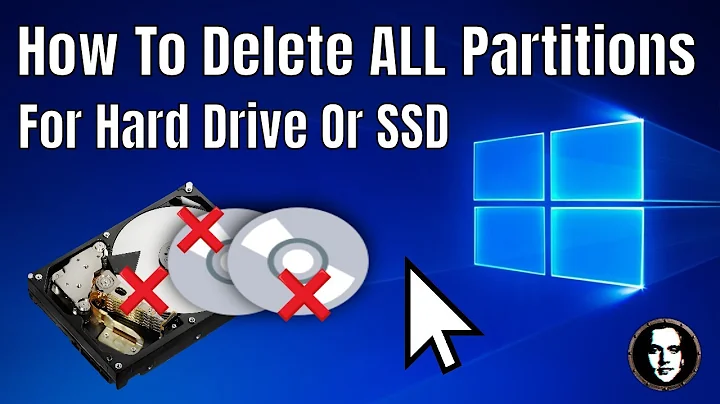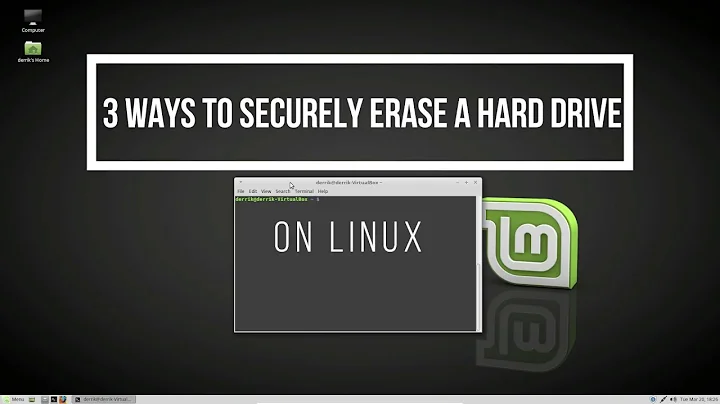Quickest way to wipe an SSD clean of all its partitions for repartitioning in Linux?
Solution 1
On an SSD: You can TRIM whole disks or partitions using blkdiscard. It's not very secure, but practically instant (the disk merely marks all cells as unused).
For SATA SSDs, the ATA "Secure Erase" command (available through hdparm) is also very fast. There is also "Enhanced Secure Erase", which (at least on the SSDs I've used it on) takes a few seconds longer and appears to physically erase all cells.
For security: Use full-disk encryption. Don't bother wiping the entire disk if it's encrypted – you only need to wipe the area containing your keys (e.g. the first 1–2 MiB of every encrypted partition).
For repartitioning: Again, don't bother erasing all data. You only need to destroy the filesystems using wipefs, then scrub the first 1 MiB of your disk to purge leftover bootloaders. After you format a partition using mkfs, the OS will simply assume it is completely empty.
(In fact, on Linux, mkfs.ext4 will automatically TRIM the entire partition before formatting it.)
Solution 2
As Kamil Maciorowski mentions, the best way, with the least write-wear, of deleting an entire disk, is to use the ATA 'secure erase' command.
This will instruct the hardware to do a single full wipe, rather than overwriting the cells repeatedly as with tools like shred.
This can only be done for the entire disk, if you need to selectively wipe partitions, see grawity's answer (blkdiscard)
The exact implementation of the command depends on the hardware.
Most SSDs will use a bulk electric signal to wipe entire chips in an all-or-nothing fashion. This does incur (normal) write-wear, but only to the minimum extent possible (~ single write cycle).
Self-encrypting SSDs will usually just wipe the encryption key inside the controller chip (really instantaneous). Self-encrypting drives always encrypt, even out-of-the-box (with a factory-default key). So wiping the key leaves only un-decryptable jumble on the flash chips, even if no user-key was set.
-
Spinning-Rust hard-disks will do a hardware-based zero-write of all sectors, which is equivalent (and as time-consuming) as doing
dd if=/dev/zero.
The process is documented quite well here: https://www.thomas-krenn.com/en/wiki/SSD_Secure_Erase (I have personally used this process repeatedly on my own SSDs when re-installing OS'es)
Edit: if you're interested in the security implications: check this Security.SE's question
Solution 3
Keeping in mind you've asked for a solution on how to quickly wipe disks Replace /dev/sdx with your disk, most likly /dev/sda
This will wipe the partition table.
dd if=/dev/zero of=/dev/sdx bs=1024 count=50
This will wipe the entire disk, it will take a while.
cat /dev/zero > /dev/sdx
Related videos on Youtube
IgDV
Updated on September 18, 2022Comments
-
IgDV almost 2 years
I want to wipe an SSD clean of all its partitions and data, so I can repartition it (this is not for security purposes).
I've looked at
sudo dd if=/dev/zero of=/dev/sdb bs=1Mbut if this just fills each partition with zeros, I'm not sure this what I want to do.I plan to run this command quite often, and I don't want to exhaust my SSD's writes. Could anyone give me advice on tackling this problem?
-
Kamil Maciorowski over 6 yearsStudy this: ATA Secure Erase. I have no experience with the process, so this is not an answer, just a hint. Anyone feel free to write your own answer about this if you know this is the right way.
-
user1686 over 6 yearsFor security purposes, or merely because you need to repartition?
-
IgDV over 6 yearsmostly just to repartition
-
 ssimm over 6 years12 gauge pump-action. And you knew someone was going to say it sooner or later!
ssimm over 6 years12 gauge pump-action. And you knew someone was going to say it sooner or later! -
Daniel R Hicks over 6 years@ssimm - My preference is a charcoal barbecue.
-
Kaustubh Sariputra over 6 yearsYou command should wipe the whole disk. It may need a partition rescan for the
sdbXdevices to vanish, but the partitioning is removed when you overwrite the first few megabytes of the disk. -
sleske over 6 years@IgDV: The fact that this is not for security purposes is critical to your question, so I have edited it to add this. Please review and correct as appropriate :-).
-
sleske over 6 years@ssimm: That's a very drastic form of repartitioning.
-
 Firebug over 6 yearsWhat's your SSD estimated TWB? It's pretty hard to kill a SSD these days...
Firebug over 6 yearsWhat's your SSD estimated TWB? It's pretty hard to kill a SSD these days... -
Paul over 6 yearsI think you don't have to do anything at all. The partition tool will overwrite the existing partition table.
-
-
 Ruslan over 6 yearsIs Secure Erase supported by most ATA disks? I was under the impression that its support is uncommon.
Ruslan over 6 yearsIs Secure Erase supported by most ATA disks? I was under the impression that its support is uncommon. -
 el.pescado - нет войне over 6 yearsFor repartitioning, why not just delete old partitions and create new ones?
el.pescado - нет войне over 6 yearsFor repartitioning, why not just delete old partitions and create new ones? -
user1686 over 6 yearsBecause if you create new partitions at the same location (start position), you'll just find the same old data in them! (Of course that's usually not a problem, because reformatting with
mkfswill trash it anyway. But various odd situations do happen –wipefsexists because it was needed.) -
 Jules Kerssemakers over 6 yearsI haven't found a (modern, SATA) disk yet that didn't support it, but I admit my experience is limited to harddrives I have personally owned. There also seems to be a difference between "secure erase" and "enhanced secure erase", with the latter one being less supported.
Jules Kerssemakers over 6 yearsI haven't found a (modern, SATA) disk yet that didn't support it, but I admit my experience is limited to harddrives I have personally owned. There also seems to be a difference between "secure erase" and "enhanced secure erase", with the latter one being less supported. -
IgDV over 6 yearsWhat command will I need to use to apply this to
/dev/sdbjustwipefs /dev/sdb? -
Tonny over 6 years@Ruslan I have never seen (or heard of) a SATA-2 specification disk that didn't support it. Just about any SATA disk made in the last 10 years or so should have it.
-
 Timo over 6 years@IgDV - what does
Timo over 6 years@IgDV - what doesman wipefssay? (Hint: look at the first example in the man page's examples section) -
Micheal Johnson over 6 yearsDo not use
cat. Useddto improve performance. -
Maciej Piechotka over 6 years"you only need to wipe the area containing your keys" - on SSD the keys are likely to be recoverable as well. TPM or strong password protecting keys might be better option.
blkdiscardwould be nice too as it would create a puzzle out of rest of the disk even if attacker knew key (assuming the old mapping cannot be recovered as well). "then scrub the first 1 MiB of your disk to purge leftover bootloaders" - the extra section is used only as overflow of first 512B. If you wipe first 512B you're not harmed by the rest of 1M. -
user541686 over 6 yearsDoes this also mean that on self-encrypting SSDs the TRIM command is a no-op? (Otherwise it's not always encrypting, right?)
-
user1686 over 6 yearsSure, those keys normally are password-protected or even TPM-protected.
-
user1686 over 6 years@Micheal You say that, but by default
dduses 512-byte buffers, which will ruin performance... Coreutils (cpand presumably alsocat) have a more sensible buffer size. There's nothing aboutddthat makes it somehow inherently faster, anyway. -
Zoredache over 6 years@Mehrdad why would trim be a no-op on encrypted drives? Isn't the trim an operation sent from the operating system saying that a given block(s) are not being used for storage? The running OS will see the volume as if it wasn't encrypted.
-
user541686 over 6 years@Zoredache: Well it probably isn't implemented that way, but the problem in that case is that it would expose empty space as zeros. Genuine full encryption would encrypt empty space just like anything else. But TRIM would mean the drive is not encrypting the empty space.
-
user1686 over 6 years@MaciejPiechotka: Unfortunately, some bootloaders (grub in particular) also use the space after the MBR.
-
Maciej Piechotka over 6 years@grawity Doesn't matter. As long as MBR is erased there isn't a program which would load anything from this partition so it shouldn't affect anything. Just like erasing MBR doesn't remove the OS and files are still, technically, there.
-
sleske over 6 years@Mehrdad: Yes, using TRIM on an encrypted SSD leaks information about which blocks are free. Whether that is acceptable depends on your security needs. See e.g. askubuntu.com/questions/399211/… for a discussion.
-
Micheal Johnson over 6 years@grawity You can change the buffer size with
dd. Last time I tried to usecatto write an image to a disk, it was significantly slower than usingddwith an appropriate buffer size.




